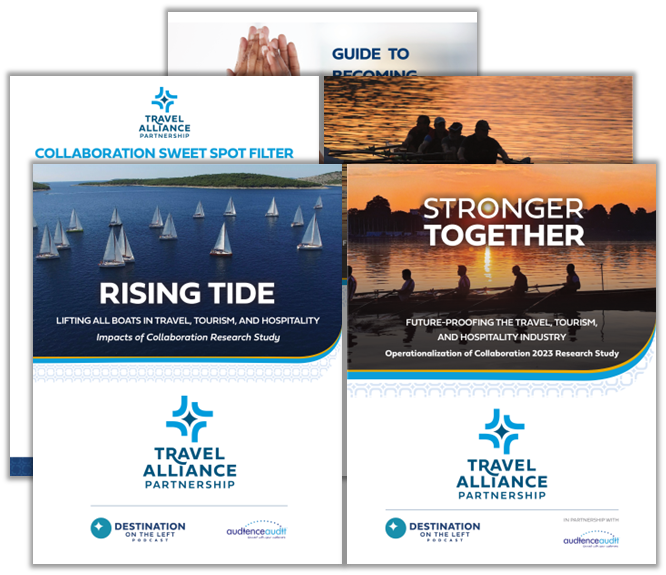Communication: The 3 C’s of World-Changing Collaborations
Big ideas and big achievements don’t happen alone. They require teamwork and a shared goal. That’s why collaboration is essential, especially in the travel and tourism industry.
But what makes a collaboration truly successful? Through years of conversations and collaboration research, I developed the 3 C’s Framework to guide world-changing partnerships.
The 3 C’s are Communication, Commonality, and Commitment. These three elements are the foundation for creating and sustaining powerful collaborations. This blog series will explore each “C” of the Framework in detail, starting with the first: Communication.

When I ask experts on my podcast, “How do you lay the groundwork for collaboration?” the most common answer is clear: communication. Open, honest, and effective communication is the backbone of any successful team effort. There are four strategies that can help you master this key component, and we’ll explore them here to ensure you start your collaborations on the right foot.
Build a Plan for Communication
Effective communication doesn’t just happen. To truly convey ideas, align on a vision, and inspire action, you need a plan. Here’s how to plan for communication:
- Define Your Audience: Start by identifying who you’re communicating with. Which organizations are involved? Who is the main contact for each one, and what are their roles? Knowing your audience ensures the right message reaches the right person.
- Clarify Your Messages: What information needs to be shared? Think about regular updates, key milestones, or shared project plans. Decide what’s essential to keep everyone informed and aligned.
- Choose Your Format: How will you share information? Options might include emails, virtual calls, in-person meetings, or a shared document online. Pick formats that suit the goals and participants of your collaboration.
- Set a Schedule: Consistency is key. Will updates happen daily, weekly, or only at key milestones? A clear timeline prevents confusion and keeps the team on track.
- Assign Responsibility: Decide who will take charge of communication. Will one leader handle it, or will duties be shared within the team? Clear ownership ensures no details fall through the cracks.
A thoughtful communication plan sets the stage for smooth collaboration, ensuring everyone stays informed, aligned, and engaged.
Set Realistic Expectations
As Tony Robbins wisely puts it, “Setting goals is the first step in turning the invisible into the visible.” Clear goals and well-defined roles are the foundation of a successful collaboration. Here’s how to set your team up for success:
- Define Clear Goals: Be specific about what your collaboration aims to achieve. What are the concrete outcomes you’re all working toward?
- Establish Roles: Identify each participant’s role and responsibilities. Ensure everyone knows who’s accountable for what to avoid confusion later on.
- Set Expectations Early: Discuss timelines, deliverables, preferred communication methods, and potential challenges upfront. Transparency at this stage avoids misalignment down the road.
Taking the time to agree on goals, roles, and expectations at the start can make all the difference. It minimizes misunderstandings and helps your team stay focused as you build something extraordinary together.
Have a Shared Vision
A shared vision is the glue that holds any collaboration together. Everyone involved must believe in and work toward the same goal. Here’s how to create that unified vision:
- Paint the Big Picture: Clearly describe the world-changing idea your team is striving for. What does success look like? Help everyone see and feel the end result you aim to achieve together.
- Define Success: Be specific about how you’ll measure progress and know when you’ve reached the goal. Clear markers of success keep everyone aligned and motivated.
- Celebrate Milestones: Highlight smaller achievements along the way. These wins will keep the team energized and committed to your larger vision.
When everyone buys into the vision, you create not just alignment but also a shared sense of purpose that fuels the collaboration forward.
Transparency is Key
Openness and honesty are the foundation of any successful collaboration. Here’s how to lead with transparency:
- Be Genuine: Show up with authenticity and a commitment to the collective good. Hidden agendas will only create barriers to trust and progress.
- Have Courageous Conversations: Address concerns or uncertainties about your role early on. Difficult discussions may feel uncomfortable, but they prevent misunderstandings down the line.
- Prioritize the Bigger Picture: Always focus on achieving the shared goals. When every team member is transparent about their intentions and contributions, it strengthens trust and unity.
Transparency fosters trust, alignment, and collaboration, positioning your team to achieve its world-changing vision.
The Next Step to World-Changing Collaborations
Clear communication builds the foundation for strong collaborations, but the next step is finding what truly connects us. In the next post, we’ll explore the second C in the 3 C’s Framework: Commonality.
Related Posts
How Curated Experiences Can Help Your Tourism Marketing
In years past, travelers may have been satisfied to see sites like the Eiffel Tower or Colosseum; now they want to get behind the scenes,...
Driving Visitation Through Culinary Tourism
When visitors come to a destination, they’re looking for experiences that feel authentic and unforgettable. Few things connect people—or capture the essence of a place—like…
